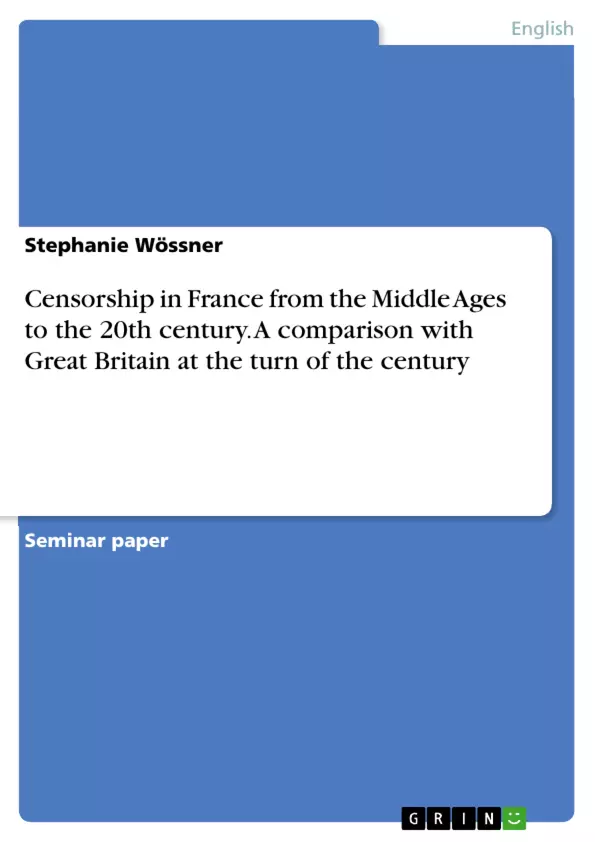Robert Atkins in his essay “A Brief and Idiosyncratic History of Censorship” observes that censorship is unique to the human species and that it both transcends cultural boundaries and predates recorded history. Wondering if this phenomenon of preventing certain ideas to be heard by the vast majority of people is caused by a “hormonal instinct to dominate and control” (Atkins) he concludes that it may come from a “misguided but ever-so-human nature,” (Atkins) and that its results vary from very tragic to very amusing as the examples cited a little later will prove.
Beginning with a commonly acknowledged definition of the term “censor,” a short history of the phenomenon from the early Greeks up to the present, and some examples of censured works of art, this paper is going to address the issue of censorship in France from the Middle Ages to the twentieth century.
The historical development in France will be followed by a description of censorship in Great Britain at the turn of the last century, i.e. the turn from the nineteenth to the twentieth century, as well as a contrastive analysis between reasons for censorship in France and Great Britain at the time. Finally, there will be a very short outline of censorship in the United States, which is based on the structure of censorship in Great Britain but has undergone quite some changes from the very beginning.
Inhaltsverzeichnis (Table of Contents)
- I INTRODUCTION
- 1. Definition: "censor"
- 2. Censorship from the Early Greek Democracy up to Modern Times...
- 3. Some Examples of Censorship in Artistic Expression
- II MAIN PART.
- 1. Censorship of the written word in France from the Middle Ages to the Twentieth Century
- a. Before the Fifteenth Century.
- b. Fifteenth Century...
- c. Sixteenth Century..
- d. Seventeenth Century..
- e. Eighteenth Century..
- f. Nineteenth Century
- g. Twentieth Century.
- 2. Censorship in Great Britain at the Turn of the Last Century
- a. A Very Brief History of Censorship in Great Britain
- b. The Printing Press and Censorship in Great Britain
- c. Censorship by the Circulating Libraries Association at the Turn of the Century (according to Nicholas Hiley)
- 3. Comparison of Reasons for Censorship in Turn of the Century France and Great Britain
- 4. Imitation and Development: The United States on the Traces of Great Britain
- III CONCLUSION.
- 1. The Dilemmas of Censorship.
- 2. Open Questions and Interesting Aspects.
- 3. The Present and the Future.......
- IV WORKS CITED
Zielsetzung und Themenschwerpunkte (Objectives and Key Themes)
This paper aims to explore the phenomenon of censorship, tracing its historical development from the ancient Greeks to the 20th century, with a particular focus on France and Great Britain. The paper analyzes reasons for censorship and compares those found in France and Great Britain at the turn of the 20th century. Finally, the paper briefly outlines censorship in the United States, drawing parallels with the British model.
- Definition and historical context of censorship
- Censorship in France from the Middle Ages to the 20th century
- Censorship in Great Britain at the turn of the last century
- Comparison of reasons for censorship in France and Great Britain
- The development of censorship in the United States
Zusammenfassung der Kapitel (Chapter Summaries)
The introduction defines the term "censorship," provides a brief historical overview of the phenomenon, and outlines the paper's focus on censorship in France, Great Britain, and the United States. Chapter 1 explores the development of censorship in France from the Middle Ages to the 20th century. It examines how different historical eras, from the pre-fifteenth century to the modern era, shaped censorship practices in France. Chapter 2 then focuses on censorship in Great Britain at the turn of the last century. It examines the role of the printing press and the Circulating Libraries Association in shaping censorship during this period. Chapter 3 compares the reasons for censorship in France and Great Britain at the turn of the 20th century. Finally, Chapter 4 examines the development of censorship in the United States, tracing its roots in the British model and highlighting subsequent changes.
Schlüsselwörter (Keywords)
The paper explores the history and practices of censorship in different societies, focusing on the role of state power, cultural values, and social norms in shaping the control of information. Key themes include the definition of censorship, historical development of censorship practices in different countries, reasons for censorship, and the impact of censorship on artistic expression.
- Citar trabajo
- Stephanie Wössner (Autor), 2002, Censorship in France from the Middle Ages to the 20th century. A comparison with Great Britain at the turn of the century, Múnich, GRIN Verlag, https://www.grin.com/document/138141



